An inconvenient history of Ukrainian theater: how the sixties and experimenters of the 90s undermined the official Soviet scene – Publications
[ad_1]
Alternative, experimental, independent, informal, underground, studio, amateur – whatever it was called! A theater that did not fit into the system of Soviet and post-Soviet state stages, the legacy of which Ukraine still cannot overcome. Despite the fact that it has been independent for 32 years.
State Ukrainian theaters are full of old Soviet “staff”, and their repertoires and productions are still kept within the boundaries of provincialism and folklorism, which Ukrainian culture was defined in the Russian metropolis. Despite the huge demand for new Ukrainian theater that the public has shown since the beginning of the full-scale invasion.
Under the conditions of a healthy theatrical process, the avant-garde becomes the driver of change and the mainstream. But this is not about our theater. In Ukraine, by individual inclusions, the abortion of processes that could make the Ukrainian stage an original player on the international theater arena and the art of Ukrainian intellectual elites is repeated.
It is no longer possible to place the responsibility for this only on the aggressive imperial policy of the northern neighbor, although the origins of this phenomenon come from there. State theater and education remains one of the least reformed spheres of society. Why was he so resistant to many social changes and challenges? And what avant-garde ideas and experiences are worth shaping our future?
To this question especially for UP Culture a researcher of Ukrainian theater is looking for an answer Maria Yasinska. This essay is dedicated to memory Anatolia Cherkova – methodologist, teacher, inspirer of several generations of Ukrainian alternative theater. A person who organically could not fit into the official theater world and created the Kyiv theatrical underground – a phenomenon about which not a single comprehensive study has been published. Anatoly Cherkov passed away at the end of January 2024.
“When nails are cut in Moscow, hands are chopped off in Kyiv”
A long time after the destruction in the 30s Lesya Kurbas and his school, almost everything does not fit into the framework of the “official” Soviet theater culture. The theater of the Ukrainian SSR had a function defined by the party – to be part of the general propaganda machine and to carry relevant ideas to the masses.
Ukrainian studio theater gained the energy of rebellion precisely during Soviet times. It is then that a halo of environment for the chosen forms around him, which is able to accumulate free-thinking, intellectualism and tools of public expression of protest. Where things are possible that were impossible on the state stage or in official educational institutions of the Ukrainian SSR.
Paradoxically, the hotbeds of free-thinking were sometimes born “under the patronage” of the Komsomol itself, which was supposed to control all artistic and cultural activities, including the work of studios. So Club of creative youthregistered on the initiative of the Central Committee of the LKSMU in 1960.
KTM carols from Maksym Rylskyi, winter 1959/1960
Family archive of L. Tanyuk and N. Kornienko.
KTM is perhaps the most successful project of the Ukrainian “alternative”, because the direction of its founder Lesya Tanyuk went far beyond the box of the scene. Ivan Dzyuba, Lina Kostenko, Mykola Vingranovskyi, Leonid Grabovskyi, Yevhen Sverstyuk, Ivan Svitlichnyi, Vasyl Symonenko, Oles Berdnyk, Stanislav Telniuk, Serhii Paradzhanov, Alla Gorska, Viktor Zaretskyi, Opanas Zalivakha, Lyudmila Semikina, Galina Sevruk, Galina Zubchenko – thanks to this explosive concentration of Ukrainian artistic elites, the Club naturally had the level of multidisciplinarity that modern art institutions can only dream of.
The theater section of KTM was only one of five. There were also writing, art, music and film sections. The division into sections was conditional. Jazz ensemble, poetry readings in artists’ apartments and creative workshops, debates, parties, translation activities, street demonstrations, musical performances, caroling, group trips to explore abandoned monuments of Ukrainian heritage, literary evenings, performances and political activism… The activities of KTM are rapidly and widely penetrating Ukrainian cultural life, creating centers in Lviv, Kharkiv, Odesa and Dnipro.
I called it the first creative cluster, truly innovative: with the generation of new ideas for building the state. It’s not just about the work of directors, artists, actors. No, they built the state on the basis of culture. It was a cluster that, I daresay, set the stage for civil society.
Nelly Kornienko, art critic and wife of Lesya Tanyuk.
If the “experiments” of Kurbas end with his shooting in the Sandarmoh tract, the “sixties” did not just officially declare themselves the successors of the “Shooted Revival”. In parallel with artistic activities, KTM conducts political activities, investigates and forces the authorities to publicize the burial of victims of the NKVD in Bykivna. Les Tanyuk, Alla Gorska and Vasyl Symonenko were the first to open this burial.

Les Tanyuk and Nelly Kornienko during a trip to the Carpathians, 1968.
Family archive of L. Tanyuk and N. Kornienko
The young man took part in the rehearsals of the KTM-iv studio performance of young Tanyuk Vyacheslav Chornovil. “I drowned such bastards in the seventeenth year!” – the director of the institute pointed at Tanyuk during his studies at the Kyiv Theater Institute Semyon Tkachenko.
Director Les Tanyuk also acted on the official stage. But the Soviet authorities closed all three of his Ukrainian performances even before the premiere. Although tickets for some of them were sold out 10 shows in advance. An invitation to Moscow initiated by an influential Russian playwright saved the director from arrest, the order for which has already been issued Sergey Rozov.
“He was too thin for this machine”
Another hero of our short essay Anatoly Cherkov returns to Kyiv after studying and opens his first studio in 1977. Churches had connections with the Sixties movement. However, this is precisely the year when the youngest sixties – the founders of the Ukrainian Helsinki Group – were repressed. The event marked the final consolidation of the stagnant Brezhnev era in Ukraine.

Anatoly Cherkov at the rehearsal.
Photo by Oleksandr Pertulenkov.
Nevertheless, his poster “Ukrainian Workshop” in predominantly Russian-speaking Kyiv, it presents an exquisite mandala of Ukrainian and Western texts: “On the Field of Blood” and “Farewell” by Lesia Ukrainka, “Silent Evening” by Oleksandr Oles, “Stefanyk – Tychyna”, “Human Voice” by Jean Cocteau, “Evening” by Natalia Chechel , “Krapp’s Last Tape” by Samuel Beckett, “Yerma” by García Lorca.
However, Cherkov was not interested in creating plays in their classical sense. All his life he developed a system of polyphonic improvisation and was primarily interested in the emergence of free-thinking theatrical youth in Ukraine. Education of consciousness, which is able to choose its own path by being aware of the diversity of practices and systems. Consciousness with which it is interesting to be in dialogue.
After graduating from school, I faced a significant problem – the need to return to the basics in everything: it was difficult to speak, think, answer without expecting evaluation from others. I was forced to rebuild myself. And the theater helped me in this. It was the “Polyphonic Improvisation Studio”, where Anatoly Cherkov, Yurko Yatsenko, and Shura Tokarchuk taught. It was a world where we learned to start all over again in order to create sincerely and openly, to fantasize, to trust ourselves. Confidence in one’s abilities gave birth to a world similar to childhood. It is impossible to return to “cannot”. Having obtained a second degree in theater studies, I decided to create a play space with children.
directed by Iryna Zapolska
Over 47 years, an impressive number of people have passed through Cherkov’s studios. Directors are among them Vlad Troitskyi, Alla Zamanska, Anatoly Neyolova rock musician Oleg Skrypka and many, many others. The brightest outburst of activities of the studios occurred in the 80s and 90s. Performances of “Ukrainian Robitna”, “Institute of Theater” and “Studio of polyphonic and constructive improvisation named after Tana Golubentseva” gathered full halls of young people.

Serhiy Proskurnya, Hryhoriy Gladiy and other spectators at the show at the Studio of Polyphonic and Constructive Improvisation
Photo by Oleksandr Pertulenkov
I remember the following announcement appeared in my academic dormitory: “Those wishing to take part in the creation of a theater of constructive and polyphonic improvisation are invited to the address Mykhailivskyi Uzviz 14 on such and such days, at such and such hours.” I was bribed precisely by the fact that they already perceive me a priori as a subject of the process, and they are not going to shape me and make something out of me.
directed by Evgeny Lapin
In the foundations of the Cherkov theater, there really lay not only a different theatrical optics, but also a different ethic that was ahead of its time. It is only now beginning to be introduced as a norm in the European theater – the creation of a space without the traditional hierarchies of director-actor, luminary-beginner.
His theater had something that fundamentally distinguishes it from other theater innovators of the 20th century – the absence of violence. In the methods of cult figures of the theater world of the last century, there was a lot of work with the dark side of human nature. Fear allows actors and viewers to get a special, extreme experience. Anatoly Cherkov’s theatrical world is a play theater of people free from fear. My memories of the world of the evil 90s are filled with light, in many ways thanks to the people of the environment, which was formed by the theater projects of Anatoly Cherkov.
film expert Aksinya Kurina
Why did Anatoly Cherkov’s professional activity, which lasted for decades, remain in the studio format, why did he not become the founder of the theater? How did such a significant figure end up in a marginal position and people of the new generation hardly know about it? Firstly, because of the economic crisis of the 90s, which nullified the ambitions of artists. Few people from this generation managed to become a successful producer of their creative pursuits.

Studio Church street action.
Photo by Oleksandr Pertulenkov
Secondly, because of the exceptional conservatism of the theatrical nomenclature of that time. After 1991, in the new Ukraine, already open to the world, a new theatrical mainstream could emerge – a modern one. If, for example, Anatoly Cherkov was invited to teach at the Kyiv Theater Institute, but it was impossible to imagine.
“He was always outside: he was too different from all this, although he insisted that we enter the theater. I really didn’t want to, because I had many friends from there, and he said: “You can not study there, but you should know that you can enter”… He was too thin for this machine. His theater was in no way related to the Ukrainian theater of that time. He wouldn’t fit in there. He was a separate planet.
director Olga Gavryliuk
Cherkov’s Planet was not the only one in Kyiv in the 80s and early 90s. It is at this time that students of the world-famous theater reformer return to Ukraine after studying in Moscow, full of enthusiasm, new ideas and technologies Anatolia Vasiliev: Yuriy Yatsenko, Volodymyr Kuchynskyi, Valery Bilchenko, Oleg Liptsyn. This is the period of reconstruction and the beginning of independence. The air is full of hopes for the better and anticipation of change.
However, surviving in the Ukrainian theater landscape from the whole generation of young geniuses is possible only in Lviv theater Volodymyr Kuchynskyi. In 1988, together with a rebellious group of actors who resigned from the Zankovetska theater, they got their own premises and Lviv Kurbas Theater. The capital’s history developed more dramatically and is worth a separate essay…
[ad_2]
Original Source Link











